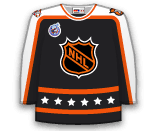Ludvig has not played since his NHL debut on October 24th when he suffered a concussion that has forced him to miss the last 11 games for the Penguins. Last season with the Charlotte Checkers of the AHL, Ludvig had 17 points (3G / 14A) in 54 games.

Ludvig has not played since his NHL debut on October 24th when he suffered a concussion that has forced him to miss the last 11 games for the Penguins. Last season with the Charlotte Checkers of the AHL, Ludvig had 17 points (3G / 14A) in 54 games.


Rust will miss Wednesday vs. the New York Rangers after it was announced he was day-to-day with a lower-body injury. If he is forced to miss an extedned chunk of time it would be a shame as the 31-year-old winger is on pace for career highs in almost all categories as he has nine goals, seven assists, 55 SOG, and a +10 plus/minus through 17 games played.


Staal will play for the first time since suffering an upper-body injury on October 19th against the Edmonton Oilers. Louis Belpedio will be a healthy scratch on Wednesday to make room for Staal, who is expected to skate alongside Egor Zamula on the Flyers' third defensive pair.

Vasilevskiy has not played this season after undergoing back surgery in September. Lightning head coach Jon Cooper said Vasilevskiy might debut on the team's upcoming road trip, which would be right on cue with his original 8-10-week prognosis. Jonas Johansson has occupied the Lightning crease for the majority of Vasilevskiy's absence and, despite a recent decline in play, will likely continue to see a steady share of action while Vasilevskiy re-acclimates himself to game-action before taking his rightful place as the bonafide starting goalie.

Kuznetsov did not play on Saturday due to an illness and, after participating in the Capitals' morning skate on Wednesday, is still expected to be out of to the lineup against the Buffalo Sabres. After a poor start to the season, tallying a single point (0G / 1A) in his first five games, Kuznetsov has turned things around with seven points (3G / 4A) in his last nine while seeing over two extra minutes of time-on-ice. He is expected back for the Capitals' next matchup.

Barkov did not practice on Wednesday, indicating he will likely miss his second consecutive game due to a knee injury. Barkov has been terrific this season, tallying 17 points (6G / 11A) in 16 games playing predominantly alongside Sam Reinhart on the Panthers' top line. Anton Lundell will move up to the top line, centring Eetu Luostarinen and the previously mentioned Reinhart.


Glass picked up his first assist, of the season and played 13:07 TOI Monday vs. Colorado but was announced week-to-week with a lower-body injury and has been placed on the injured reserve. The 24-year-old has struggled mightily out of the gate in 2023-24, with one assist, 17 SOG, two PIMs, and a -2 plus/minus in nine games after putting up 14 goals and 35 points in 2022-23.

Grubauer left the Kraken's game Monday vs. Calgary after the first period due to an undisclosed injury and did not practice Tuesday. He is considered day-to-day and Chris Driedger is expected to get the call-up in his absense. The 31-year-old netminder is on pace for his worst statistical season in his three years in Seattle, as he is 5-6-0 with a .885 SV% and a 3.36 GAA.

Harvey-Pinard has missed the Canadiens' last two games due to a lower-body injury and will now be out 6-8 weeks. It's a tough loss for the 24-year-old sophomore, who has four assists, 11 SOG, two PIMs and a +1 plus/minus in 13 games played prior to his injury.

Harris joins the Canadiens' already lengthy list of injured players as it was announced Tuesday that he would be out indefinitely with a lower-body injury. The 23-year-old defensive defenseman has yet to find the back of the net this season with no goals, three assists, 12 SOG, eight PIMs, and a -7 plus/minus in 16 games prior to his injury.

Rust is being evaluated by the Penguins' training staff Tuesday for a lower-body injury and is considered out until there are more updates. If he is forced to miss a chunk of time it would be a shame as the 31-year-old winger is on pace for career highs in almost all categories as he has nine goals, seven assists, 55 SOG, and a +10 plus/minus through 17 games played.

Rakell has struggled so far in 2023-24 with no goals and only four assists, 44 SOG, two PIMs, and a -2 plus/minus in 17 games but will now be forced out long-term with an upper-body injury. The 30-year-old right winger joins Bryan Rust, and Chad Ruhwedel on Pittsburgh's growing injury report Tuesday.

Ruhwedel left the Penguins' game Sunday vs. Vegas after 10:48 TOI with a lower-body injury and is considered out week-to-week. The 33-year-old stay-at-home defenseman has an assist, nine SOG, two PIMs, and a -3 plus/minus in 15 games prior to the injury this season.

Hischier skated for his second full practice on Tuesday but will not play Wednesday as New Jersey heads to Detroit. The 24-year-old center has missed the Devils' previous nine games but is expected to practice again Wednesday. He has two goals, 14 SOG, four PIMs and a -2 plus/minus in seven games prior to his injury last month.

Walman left the Red Wings' Stadium Series showdown vs. Toronto after just 14 shifts and 12:29 TOI due to an undisclosed injury but fully practiced Tuesday and is expected to play Wednesday vs. New Jersey. It is great news for the Red Wings as their top paired defensemen has been off to a fantastic start early with four goals, three assists, 31 SOG, 18 PIMs and a +5 plus/minus in 17 games this season.


Manson hasn't placed since November 11th due to the upper-body injury. Sitting in place of Manson will be Samuel Girard, who is out with an undisclosed injury. Manson has no goals and one assist in 13 games this season.

The NHL injury report is updated daily so that you can see the latest injury news ahead of puck drop in any of today’s matchups. Seeing timely updates to the NHL injury report can make a major impact on your daily fantasy sports picks and wagers on a particular game. All information provided on the NHL injury report is provided directly by the NHL and each respective franchise to ensure accuracy.
While the minimum amount of time spent on the injured reserve list is seven calendar days, there is no maximum amount of time that a player can be placed on the injured reserve list. If a player is set to be sidelined for longer than 24 calendar days or 10 NHL games, then a club may opt to place them on the long-term injured reserve instead. This allows franchises with the ability to exceed the salary cap while a player is placed on this reserve list.
No injury recovery timeline is the same as another as there are several factors that go into the rehab process for a player being affected by injury. Factors include but are not limited to, injury severity, player injury/medical history, age, as well as the location of the injury. Some injuries are able to clear up in a matter of days, while others may take an athlete out of action for the entirety of a season.